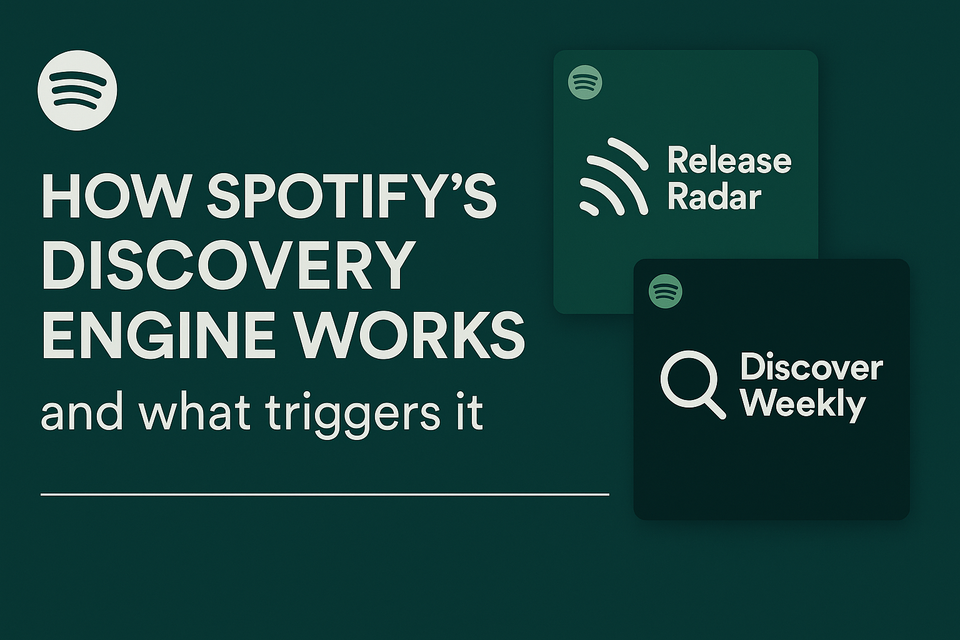How Spotify’s Discovery Engine Works – And What Triggers It

Understanding Release Radar, Discover Weekly, and Why Some Tracks Never Show Up
Many independent artists rely on Spotify to grow their audience – but few truly understand how Spotify’s internal discovery system works. Tracks appear (or don’t) in personalized playlists like Release Radar and Discover Weekly, and it often feels arbitrary.
This article explains how those systems function, what kind of data feeds them, and what you can do – realistically – to increase your chances of being featured.
1. The Difference Between Editorial and Algorithmic Playlists
Spotify operates two main types of playlists:
- Editorial playlists: Curated by human editors at Spotify.→ Access through pitching in Spotify for Artists.
- Algorithmic playlists: Generated by user data and engagement.→ No direct access – they rely on listening patterns and system signals.
The two most relevant algorithmic lists for most artists are:
- Release Radar: A weekly playlist for each user, updated every Friday. It includes new releases from followed artists and others Spotify thinks the listener might like.
- Discover Weekly: A personalized playlist, updated every Monday, based on your recent listening habits and similarities to other users.
2. Release Radar: How It Works
Your track will appear in Release Radar if:
- The user follows you on Spotify
- You’ve pitched the track at least 7 days in advance through Spotify for Artists
- Your profile is verified, and metadata is clean
Release Radar is time-sensitive. It shows new tracks for 28 days after release, but only appears once per user – usually on the Friday after release. After that, it drops out of the algorithm.
Key insight:
If a listener doesn’t follow you, your track must outperform others algorithmically to show up.
3. Discover Weekly: The Real Algorithm Test
Discover Weekly is based on:
- What similar users have played and saved
- User-level behavior: skips, saves, replays
- Playlist context: where your track is discovered
- Consistency: whether your music triggers good engagement over time
It is not about follower count or viral spikes – Discover Weekly favors long-term patterns.
To get there, you need:
- Clean data (no artificial streaming)
- Organic saves
- Tracks that hold listeners for over 30 seconds
- Above-average repeat or save ratios in the first 7–14 days
4. Why Some Tracks Never Trigger Discovery
Spotify’s system is designed to avoid recommending tracks that show any signs of:
- Manipulated traffic (click farms, loop tools)
- Poor retention (high skip or bounce rate)
- Incomplete metadata or genre mislabeling
- Playlist stuffing (inclusion in bulk, irrelevant playlists)
Even good tracks can fail to trigger discovery if the early signals are inconsistent.
It’s not always about quality – it’s often about context.
5. Spotify Radio: Passive Discovery That Still Matters
Spotify Radio isn’t a traditional playlist – it’s a dynamically generated stream based on a track, artist, or playlist.
When a listener reaches the end of a queue, Spotify may autoplay similar content – and your track could be next.
Key features of Radio streams:
- Fully algorithmic, not pitched manually
- Triggered by listener flow and autoplay
- Works well for genre-consistent, steady-tempo music
- Data flows back into other algorithmic systems (e.g., Discover Weekly)
Why it matters:
- Radio is often the first real exposure for smaller artists
- These plays can establish early behavioral data (skip/saves)
- Clean engagement through Radio can help push a track further
How to support it:
- Focus on production that flows naturally from other similar tracks
- Ensure metadata, genres, and moods are correctly tagged
- Avoid harsh intros, overly experimental formats, or untagged content
6. What You Can Do – Without Chasing the Algorithm
There’s no guaranteed way into Discover Weekly or Release Radar beyond your followers – but you can improve your odds by:
- Pitching every release through Spotify for Artists
- Encouraging pre-saves and real followers
- Avoiding any third-party playlisting services that promise numbers
- Focusing on your profile: update bios, use Canvas, and keep your discography well-structured
- Measuring performance based on saves, repeat plays, and streams per listener – not vanity metrics
Sources & References
- Spotify for Artists – How Playlists Work
- Spotify Engineering Blog – Discover Weekly
- Spotify for Artists – Pitching Your Music
- Loud & Clear Transparency Initiative
View all articles about Spotify
NexaTunes – structured support for independent releases.
Get in touch for more information using our livechat
